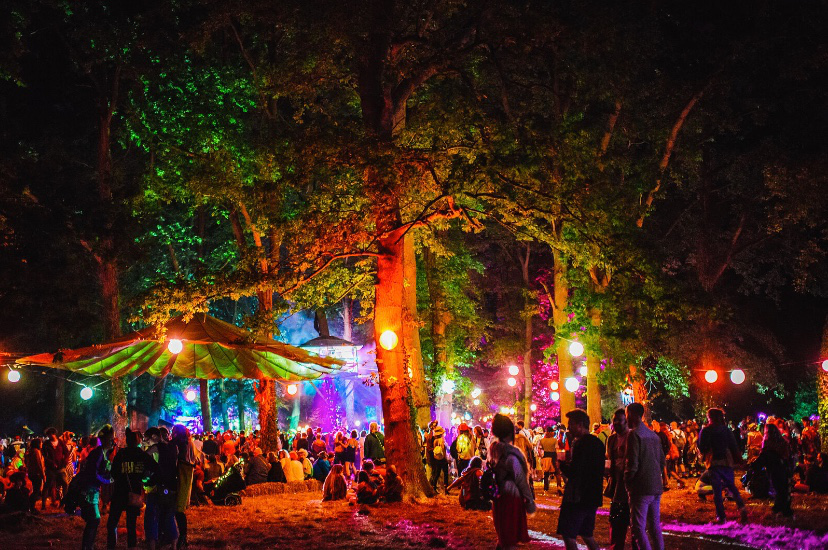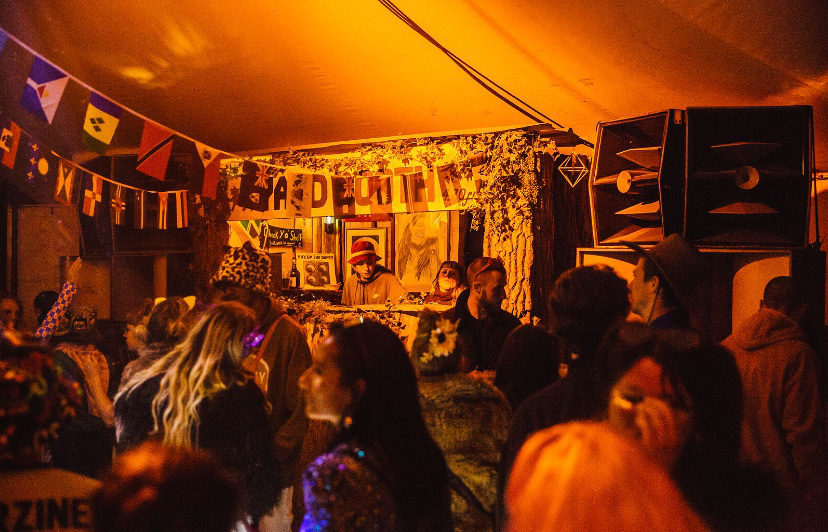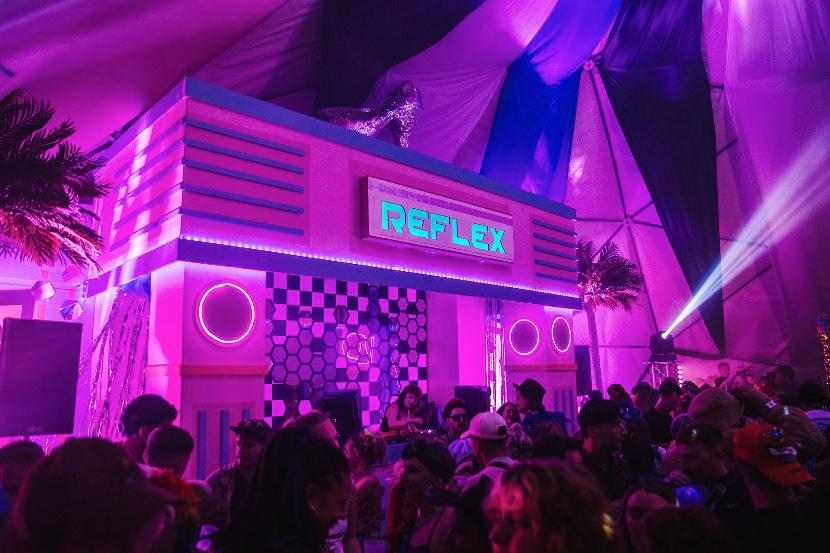Utopian Ideal: Shambala 2022
A reflection on the unparalleled world-building weirdness of a festival which occupies its own curious space in the UK party landscape.
The British festival is a curious beast. In many ways, it’s an extension of a tradition of music and dance that reaches back to pagan times (and further) – a pointedly playful subversion of the prevailing gloom in a country that historically hasn’t had quite enough sun. In a knee-jerk response to the restrictive, patriarchal society we’re born into, the British festival culture has evolved the art of unleashing the inner freak. It’s a ritual manifested by bold and creative misfits – those who sense there are ways to genuinely dissolve the divisions of a fragmented society.
In modern terms, that movement was spearheaded by the free festivals of the new age travellers, whose lifestyle feels innately rooted in a quintessential Britishness (said without even a dash of patriotism). As music and drug cultures evolved in the late 20th Century, so emerged new variations on those communal, rural themes. Glastonbury perhaps serves as the archetype – a cosmically charged setting which has undoubtedly incubated incredible resourcefulness amongst independent creative and alternative communities. The carnivals which bring Afro-Caribbean vibrancy to so many UK cities are equally influential. The free party scene can’t escape a mention either.
A whole society now exists between these havens of non-conformist lifestyle, and it’s shaped a style of event which happily carries the torch for the psychedelic era. It’s hippyish, without a doubt, and sometimes that aesthetic can be contrived, but immersing yourself in these fantasy microcosms can’t help but be a positive experience. We’re at home in these grubby, ramshackle play dens, surrounded by nature, indulging our inner child and seeing opportunities for fun everywhere we look.
Of course, every festival has it challenges. Getting that many people together for one big sesh without everything descending into chaos is never to be taken for granted. For something so vast, Glastonbury works incredibly well, but personally, the size feels like a deterrent. I don’t necessarily want a festival to be that ‘epic’. What I want is something you can sense the whole shape of, to understand every angle and soak it in. In that sense, Shambala is the perfect offering, nestled on a country estate in the Midlands, somehow hidden from the rest of the world and rich with the potential for adventure and discovery.

On the Sunday night of Shambala’s 20th anniversary celebrations, I went on a solo flight from space to space, delighting on the whirlwind of frankly unbelievable scenes unfurling in front of me. The joy spilt out of everywhere; an archipelago of intimate dancefloors with distinct vibes teeming with surrealist detail. Everywhere I went, I could only see people having the time of their lives. Someone was playing sultry Latin and Afro grooves in Phantom Laundry, acting as a beacon for the sexiest people in the festival. At the Compass, there was a sparkly-eyed lock-in vibe amongst the cheeky, loose limbed crowd. In Pink Flamingos, everyone was shimmying, shoes-off, to live jazz. At every turn, the costumes, sequins, fairy lights, glitter, body language and pure expression cast the crowd in a fantasy only enhanced by the ornate settings
The fundamental thing about Shambala is surrealism. The way art is presented there is rooted in warped twists on reality, and the 20 year deep community has responded in kind, locked into a reciprocal cycle of costume and performance almost total in its reach. It’s genuinely hard to tell who is a paid performer staging an impromptu intervention in a crowd, and who is a reveller locked into their own flight of fancy. Everyone feels inspired and encouraged to realise a little of their inner freak. To take their guard down one notch or maybe 10, let that fear of rejection or judgement drift away and do something ridiculous. Even at the Shambolympics, as fancy-dressed revellers thrust themselves into the centre of attention, the acerbic commentators serve their shade with a liberal dose of affection.
But weirdness on its own isn’t the key to a successful festival. There’s a consistency in the quality of what is presented to you, from the ethics the festival lays out as its code of conduct to the stage design, the traders and even the more functional security personnel. When you go on the Ferris Wheel, it feels like perhaps the perfect version of a Ferris Wheel, slightly nostalgic and olde worlde, but still happy to tonk out belting tunes to keep impatient kids and rave parents bouncing in the queue. When you go to the woods, you’re able to interact with a theremin-like synthesiser and catch a neon pink illuminated brass four-piece bust out a cover of ‘These Boots Are Made For Walking’, nestled in the dark, under the trees with a huddle of complete strangers. Imagine the number of magical events happening simultaneously across the site at any one time. And all these infinitesimal details are delivered to such a high standard, without a whiff of mass-production polish about the place.
The recent Trainwreck: Woodstock 99 documentary is lingering on my mind before I get to Shambala, and compared to that horror-show epitome of greed-oriented negligence, it’s frankly staggering how many ways Shambala demonstrates care for their crowd and crew. That’s also a credit to the scale of the event, where a deep-seated family has grown from the festival’s beginnings to comfortably exist in the heart of the festival. Parents have brought their children here for more than 10 years, now seeing their progeny heading off into the night for their own adventures.

The way the music operates at Shambala also continues this theme of the unusual. There is of course more on offer than anyone could rightly hope to see, and the programming is incredibly broad. It’s perhaps best defined as completely lacking in pretension and industry hype. Musical trends which tend to dominate so many festival line-ups are pleasingly lacking here, and as the industrial-festival-megacomplex continues to expand, Shambala excels in avoiding these machinations and simply booking according to its own internal logic. There’s a strong commitment to music from all kinds of cultures around the world, and lots of crowd-pleasing, straight-up fun.
There is perhaps a downside to this approach though, particularly when thinking about the dance music on offer. There are repeated moments in the weekend where the music doesn’t seem to step up to the space. Given the exquisite detail in nearly every venue you enter, there are times when I seemed to bounce from one below par drum & bass set to another. The best breakbeats I heard all weekend were in the Woodland Tribe craft area, where one of the crew had brought a monster portable speaker and started tonking out some jungle while kids whacked nails into bits of wood and clambered on rigging through the trees.

The house and disco on offer sometimes lacked the rough, passionate impact of the real deal stuff (and by that I mean Black American dance music), often erring towards the safer, slicker strains that leave an emptiness in the air where there should be fire and soul. In many ways, a lot of these sets in and around the smaller party spots sounded like something you might hear at a random house party, but I think there’s something intrinsic to Shambala in that, too. For one thing, the line-up isn’t littered with media darlings, but rather people from the community that orbits the festival.
A bit like clubbing in Berlin, in many ways it’s not about chasing a line-up to get the best out of Shambala. It can be – there’s an embarrassment of riches to look up and check out – but the festival seems more naturally suited to a free-flowing approach with openness to chance and surprise, seeking out the space that best suits your mood. It can take you to some incredible places surrounded by incredible people. It’s just that sometimes, the music bubbles below a quality threshold which would take the experience one step further.
Of course, that’s not always the case, and I shudder to think how many incredible sets I missed at any one time. There were serious bookings scattered throughout who I missed for one reason or another – DJ Storm was reportedly incendiary in the Data Mine, and I would have loved to catch ADJ’s crunchy strain of UK electro too. Last-minute line-up shuffling meant missing vital breakthrough MC Grove on Saturday night. Live acts feel like Shambala’s stronger suit, and the freewheeling approach can lead to some wonderful discoveries. On the Sunday night, I walked into the mammoth Kaleida tent to watch Bristol dubstep doyen Pinch, only to arrive late and be confronted with the searing intensity of BCUC – Bantu Continua Uhuru Consciousness, from Soweto, South Africa. Their pulverising tribal rhythm and fierce chanting powered a spacious but intensely connected crowd. In the midst of one of their extended throwdowns, the electricity in the tent peaked as the front man intoned everyone to drop into silence and connect with a lost loved one. The poignancy was thick in the air, rising like steam from nearly every person present.

Chai Wallahs, something of a secondary main stage, reverberated with joy to Eva Lazarus, Sankofas bathed in the comforting lull of an acoustic Mesadorm set, new punk venue Squatter’s Tights thrashed with glee to the sound of Foxy Acetylene. But it did feel, ultimately, like there was a certain thread of music missing. Something which would fit so perfectly into the incredible setting Shambala offers. That’s not a genre-specific idea either, but rather a certain sensibility towards experimentation and sincere expression, delicacy and subtlety, especially in electronic music, which just doesn’t feel represented across the weekend.
All this considered, on reflection with other like-minded people, there is a question of whether this lack of pretension in the bookings is just how it’s meant to be. In a way, it feels more honestly connected to that underlying British festival thing. It’s not to meant to be hip or sophisticated. I’ve spoken to plenty of cynical European party people who shudder at the thought of dusty/muddy fields and fancy dress as far as the eye can see. I personally love being swept up in the state of disarray and marvelling at it. It feels honest seeing people let go like that. That’s something true across all kinds of events, but at Shambala it’s mixed in with a sweet sentimentality and mischievousness that always looks joyous, never tragic. What the festival does to people is its true power.
I spoke to an older punk head at the Squatter’s Tights who was spellbound by it all. “I’ve never been to a festival before where everyone was so… happy,” she told me. “It took me a day or two to get into it, and to realise I could feel like that too.” She gave me her shot of Patron and a load of tips for the rest of the festival, and we chatted for a good half hour before peeling off wherever our nights took us next. I could tell she was fully caught in the feverish, infectious upward buzz of the place, and maybe that speaks to the genuine, DIY aspect of the festival as much as its swooning, loved-up demeanour.
Like an endless string of joyous moments, the interactions of the weekend spill out as fragmented memories in the warm afterglow of the festival – one where you leave nourished rather than depleted, with so much to smile about. It might sound sappy as hell, but such is the effect of a weekend being actively urged to cut loose, you don’t feel embarrassed for getting so misty eyed about something as simple as a four day party.
Header photo by Ania Shrimpton.